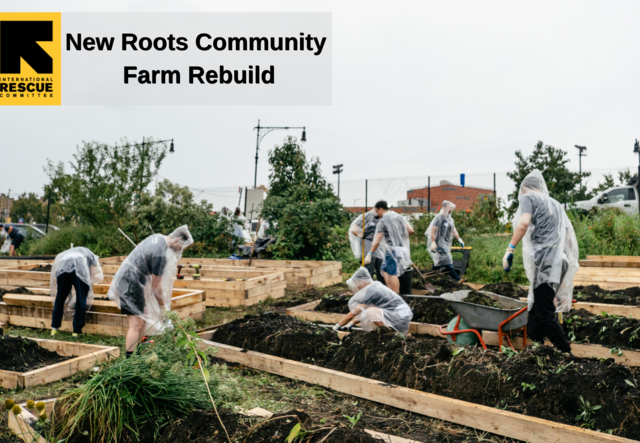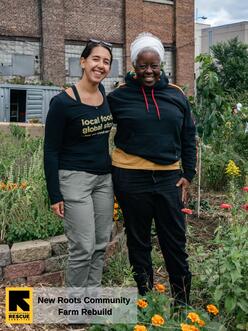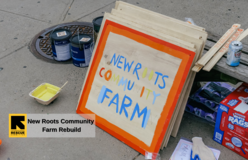
IRC in NY has two New Roots farms: one in the South Bronx that launched 7 years ago, and the New Roots Community Garden (NRCG) in Woodside, Queens, which began in 2021. This September, New Roots Community Farm’s (NRCF) community members came together to rebuild the farm! This project consisted of transplanting new plants, weeding, and installing sturdier plant beds. The New York Restoration Project also joined the NRCF in these efforts to execute the rebuild.
As a site of belonging, the NRCF responds to the transnational identities of its members. Members are encouraged to plant native seeds and exchange technical knowledge. With the rebuild, there will be more capacity to bring members’ harvests to fruition. This is critical for members interested in adopting crops, growing culturally and climate-appropriate food, whilst nurturing indigenous-friendly crops. The IRC in NY sat with Sheryll Durrant, the Food and Agriculture Coordinator at IRC in NY, to learn about the impact of this rebuild and the vision of the NRCF as a whole. Sheryll explains how this answer is shaped by the communities and the role of community farms:
“Community farms serve as a site of belonging. It is a site to celebrate the emotional value of food and foster a communicative space to learn about other cultures through recipes and knowledge exchange. These food memories represent the diversity of local communities, migrants, and immigrants across the city.” In looking towards the future, it is important to reflect on the historical relevance of community farms in the urban context of New York City.

The urbanization of NYC for many marginalized communities has long been characterized by under-resourcing and segregation. This urban condition caused destabilization of food security and limited access to public goods. Stress under urbanization was especially triggered by several development policies. One notable event that devasted the South Bronx in the 70s was the Decade of Fire where nearly 80% of the Bronx housing projects were burned and many communities were displaced. This Decade of Fire was a result of redlining policies and the regulation of the fire department's duty to respond promptly.
The Decade of Fire is one of many events that caused generational and systemic trauma. The NYC urban landscape for marginalized and migrant communities thus became a site of bareness and vacancy where communities were thrust into the margins of food and spatial apartheid. The NRCF directly considers how these lasting traumas affect the emotional well-being of its members. With this in mind, the NRCF envisions continued advocacy of members’ needs.
These communities are and have always been ready to be leaders of their green spaces. They seek to redefine their standards of urbanization through urban farming and local food projects. The NRCF supports community members through food demos, agriculture workshops on nutrition, farming and gardening, and food distribution activities. Together, members collaborate with IRC NY staff to grow and take care of crops. Members often express their interests and are provided economic empowerment support. Through this network, members have also built important social bonds.

The advent of greenspace cultivation is evidently not only a modern-day approach towards more efficient food systems. In fact, for many community members, the NRCF’s greenspace contribution to the ecosystem is about food justice. Community farms empower the practice of filling the void, brought by failed development policies, and lay the seeds for members to reclaim food and spatial sovereignty.
These roots are the pulse and grit of community farm members of the New Roots Community Farm.
With this renovation and historical significance in mind, the NRCF and the IRC in NY are hopeful for the continued evolution of their farms. It is telling how community farms affirm the value of interdependence by promoting collaboration through the nurturance and distribution of food and values. This rebuild is one of the many blueprints of community green spaces. The most important rebuild however has proven to be the acknowledgment and expansion of the community.